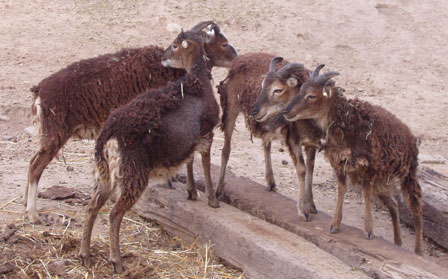Where are the simple joys of Soay maidenhood?
All my life I’ve been blessed, or cursed, with an uncontrollable urge to start singing a matching song when something or someone catches my eye. And so it came as no surprise that I found myself humming the Camelot tune as I was out photographing lambs. All of a sudden four of our yearling ewes who did not get pregnant came into view. [Side note: apparently they were too young to breed when they were with the ram.]. As you will see in the picture at the end of this post, they were standing perfectly still. But their pose reminded me to tell you about a nearly infallible indicator that a ewe did not get pregnant, is still “in the market,” and will not be needing a room in a jug or the extra hay needed to support a nursing ewe. In other words, in planning for lambing, it helps to know who is carrying a lamb and who is not.
Let me set the scene, since despite my best efforts I have never been able to capture this telltale behavior on film.
It is about two-thirds of the way through their incubation period, 15 weeks give or take. Imagine our expectant mothers lying down, hooves tucked demurely under, dreamily ruminating about winning the Cutest Lamb or Baby With Most Hair contests, when out of nowhere a crazed teenager or two caroms full tilt through the Maternity Ward kicking up her heels, shattering the serenity of her older cousins for no good reason. I am not talking a mere flick of the hoof here. Think track and field high jumps or a slam dunk, the kind of maneuvers Michael Jordan or the championship girls’ basketball team are more likely to execute. Pregnant ewes never behave like this, period, end of story.
No doubt the girls’ antics have a formal scientific explanation linked to hormones, but on a family blog I will just tell you it is unmistakable and let it go at that. Hilarious to watch, never fails to make us laugh.
Some of you may be wondering how a Soay operation headed up by a reputable scientist can be taken in by something as goofy as a silly-looking romp. I would be the first to admit that a review of the literature on sheep breeding might well provide more “objective” indicia of whether a ewe has settled (i.e., whether she successfully bred): pre-natal office visits, ultrasounds, and so forth. What about the obvious one, the size of the ewe’s belly, for example? If you want to rely on belly size, go right ahead, and it will work most of the time, or so we thought, until we ran up against the likes of Tolcarne, our little yearling ewe who produced Otley the Noisy. Remember how surprised we were when Otley showed up? No way Tolcarne looked pregnant. But we have learned our lesson. Had we paid more attention to which ewes were cavorting like ninnies instead of focusing only on bellies, we would have known that Tolcarne was settled. From now on, you can be sure we will watch for this simple joy of maidenhood — leaping at will — as a more reliable, free way to know how many lambings to plan for.
Mind you, when they are not galloping around kicking up their hooves, the Soay Sorority Sisters do what any gathering of two or more teenage girls would do — check out the boys at the dance to see which one is cutest or whatever today’s benchmark is for the one you have your eye on. Do you have any doubt that is what is going through these girls’ minds?

For now . . .